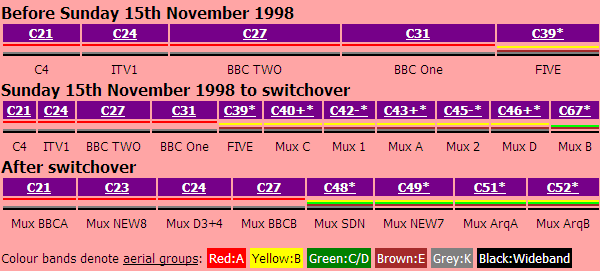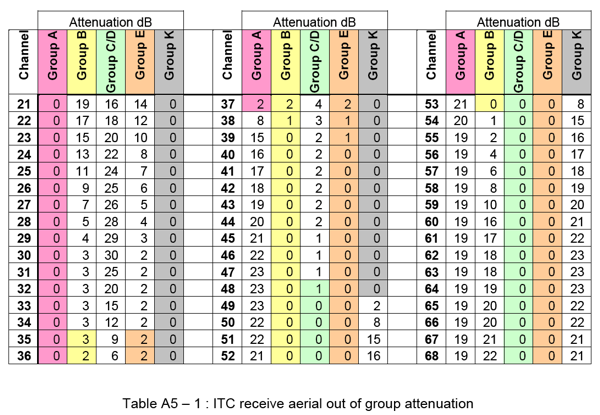Aerial groups - new feature
 Brian Butterworth published on UK Free TV
Brian Butterworth published on UK Free TV In the olden days of black and white, 405-line television, when the frequencies used were "very high" (VHF), the UK two-channel television service was provided using a just 100 transmitters and reception needed a standard aerial.
Later the system was upgraded to "ultra high frequencies" (UHF) for colour and now uses over 1,120 transmitters with more channels on more frequencies.
To enable the best quality reception possible, UHF television aerials are produced in a number of "groups". Each group is designed to operate on a range of channels, blocking all others. This is to prevent interference from "other" transmitters and to decrease losses on those required.
Each group is designated a colour, which is used to mark the aerial. Whilst wideband (black) aerials are designed to receive on all frequencies, their performance can be below a grouped aerial.
The transmitter pages now show a table like this:

The three sections show the three phases. The first is that before digital TV was introduced. This example shows that a group A (red) aerial would have received the original four channels but a group K was required to also receive FIVE. The channel number for FIVE on analogue is shown with an asterisk because it is "out of designated group", group A.
The second section shows the "digital with analogue" phase, where the transmitter has the analogue services from above with the new low power digital services. It can be clearly seen that on this transmitter a group A aerial will not receive any digital services at all, and that even a group K aerial will not receive the multiplex B service on C67. The only choice for digital reception here is a wideband (black) aerial because it is the only coloured band that crosses from left to right.
(You can also see that some of the digital services have plus and minus symbols. This indicates these transmissions use a 166.67kHz offset.)
The final section shows the designated frequencies that will be used for digital television after switchover. Whilst the public service multiplexes BBCA, BBCB, D3+4 are back "in group" (group A), to receive all the multiplexes, including the two potential new ones, the only choice here is wideband.
The performance of grouped aerials for each transmission channel was defined by the old Independent Television Commission (ITC) and is:

The larger the value, the lower the signal level possible.
8:40 AM
Q1:So whats the H for?
Digital Transmitter
Name:Preseli
Reception: 4444
Region: Wales
Grid SN 17204 30670
Distance: 47
Bearing: 328
Aerial Group Now: B H,B H
Q2:any tips on replacement aerial I should buy?
previous pic: Dropbox - previous-aerial-pointing-at-Preseli.jpg - Simplify your life
| link to this comment |
9:28 AM
Stephen: H Indicates that the transmitter broadcasts in horizontal polarity (i.e. the aerial elements go side to side as in your photo).
We need a full postcode to be able to access the predicted signal strength at your location, but in general log periodic or Group K aerials offer the best option if you're in an area with reasonable signal strength and are suitable for receiving the entire UHF frequency range used for Freeview.
| link to this comment |
2:16 PM
Stephen:
Considering your location, estimated to be on the coast of the Gower where you'll periodically be exposed to very strong winds, as suggested an aerial such as a Group K Log Periodic which has low wind resistance would likely be best.
Assuming that you haven't had frequent issues in the past with picture break-up/pixellation and considering the distance I'd be picking the 28 element one such as -
28 Element Log Periodic Group K Aerial - Blake UK
If you have had more regular picture pixellation then go for the 56 element one
56 Element Log Periodic Group K Aerial - Blake UK
You'll need an F-connector for the aerial, and replace your coax with decent quality double screened cable such as CT100.
If you don't get it direct from Blake, the 28 element may be available from Tool station (31278) which although said to be the Group T stock in many stores seems to be Group K (T will work though).
| link to this comment |
2:46 AM
StevensOnln1: Just a side note; normally, polarity relates to +/- or in the case of magnetism, north/south; in this case, we talk about polarisation, do we not?
| link to this comment |
2:56 PM
I have had a Blake 52 element log aerial installed on the chimney bur am suffering pixelation on MUX 43 and 45 from Bluebell Hill.
The signal strength is 65Db.
The Aerial has Blue Ends is this correct for group K?
Thank you
| link to this comment |
9:36 PM
Michael Prior:
I take it from the way you've phrased your post, that you've had this installed by an aerial installer?
Many of Blake's Log periodics have Blue ends although technically the colour code for Group K is Grey which you are more likely to see on Yagis.
See this Blake video - YouTube
Bluebell Hill has currently been having Planned Engineering last week continuing this week -
Bluebell Hill transmitter: Possible effect on TV reception week commencing 07/10/2024 Pixelation or flickering on some or all channels
This MIGHT be the cause of your pixelation problem. As you haven't given a full postcode, we can't make any sensible comment on that.
Another possibility is very strong local interference, possibly from a new/upgraded phone mast now operating in the 700MHz band. Whilst a Group K aerial will offer a great deal of protection from that, if such a mast is very very close and on the line-of-sight to Bluebell Hill., then you might need to add a filter.
Have you received a postcard from Restore TV?
See https://restoretv.uk/post…ure/
If you can see a new/upgraded mast near you, then contacting Restore TV for a Free Filter would be a good idea.
| link to this comment |